The new second-generation GLC – third if you count the GLK – went on sale internationally in July last year, so it’s taken a while for it to get here, not a moment too soon. The GLC has been a very popular model for Mercedes-Benz India: in the financial year 2022, it was the German firm's bestselling SUV, and even grabbed the second spot after the BMW X1 in the luxury SUV sales chart. However, in FY23, its sales fell by over 30 percent due to it being unavailable from the fourth quarter of the calendar year 2022. So, does the new second-generation car have what it takes to reclaim lost ground, and what’s it like on the whole?
Mercedes Benz GLC platform and design
Like its predecessor, the new GLC is based on Mercedes’ MRA platform, though the new car uses the second iteration, the MRA II. Like the platform, the styling also is an evolution of the previous car, which means it’s handsome and elegant and not flamboyant or flashy. The body style is also more slippery now with a drag coefficient of 0.29 as against 0.31 of the earlier car.

The LED headlights are now connected to the grille, which carries the large three-pointed star in the centre with a horizontal bar splitting the grille into two halves. The bumper has a chrome appliqué below and is styled a bit like a skid plate at the bottom edge.
The profile, too, remains similar with the glasshouse swooping down after the C pillar. It has to be said that the new 19-inch, 5-spoke alloys on our test car looked really smart and that’s nice to see, especially since alloys are not something Mercedes has always gotten right in the past.
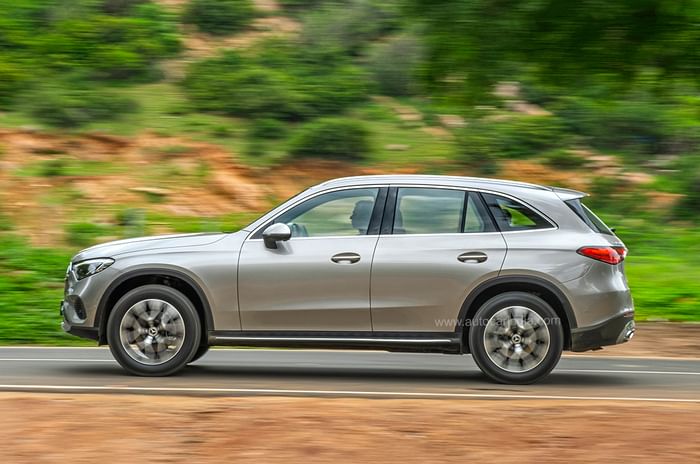
At the rear, the lights remain horizontally oriented but the LED units taper sharply inward and connect to a central bar on the tailgate. Interestingly, Mercedes has resisted the ongoing trend of a continuous light structure; the central bar is not illuminated but simply gloss black in finish. The number plate continues on the tailgate and, like the front bumper, the rear too has a chrome trim at the bottom with a slight hint of a skid plate at the lower edge and chrome lining around fake exhaust outlets.
Mercedes Benz GLC dimensions, interior space
Thankfully, the new GLC has not grown substantially and it remains a nice size for its class. Height has gone down 4mm to 1,640mm, while width remains the same at 1,890mm. Length has increased though by 60mm and it now measures 4,716mm. Wheelbase too has gone up to 2,888mm, a 15mm increase. As a result, the GLC’s cabin remains spacious with generous amounts of head and legroom. The rear seat squab, however, is short and the seats aren’t plush, the backrest in particular is firm as are also the front seats. The rear seating posture felt just right for me, but those who prefer to lean back will find the seat too upright.
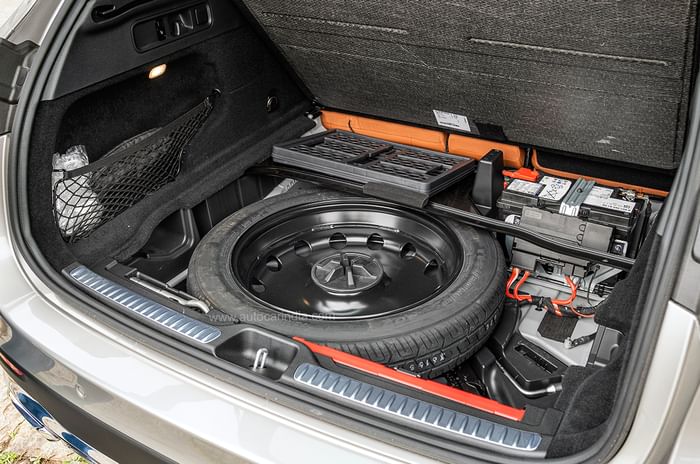
The powered tailgate opens to reveal 620 litres of boot space with the rear seats upright. What makes a big difference now, though, is unlike the previous GLC, which had the space saver spare tyre strapped to the boot floor, the spare is now located beneath, thus enabling far better utilisation of the space. The rear seat backs also flip forward via a release button on each side of the boot and the capacity increases to 1,250 litres.
Mercedes Benz GLC interior and features
As soon as you step in, a big difference from the old car is the interior design. Of course, the overall lines of the dashboard, details like the three central AC vents and the 3-spoke steering are all vaguely familiar to the previous car, but on the whole, the design is very new and modern and similar to the new C-Class.
The dashboard has the pinstripe pattern that we’ve seen in other Mercs and looks really neat here with the matte dark wood insert. The AC vents are ‘squircle’ in shape and they operate with a high-quality feel, particularly when they lock into the centre position with a very satisfying click.

The infotainment controls, which were earlier on the centre console, are now integrated into the new touchscreen that appears to float above the dash, it’s also tilted slightly (6 degrees) towards the driver. Moving the controls to the screen has freed up space for additional storage with neat cupholders and a wireless charging pad, and there's also the central armrest storage behind it that is deep and opens right down the centre.
A big update with the new GLC is the extensively digitised controls. This isn’t all good though. For instance, like all-new generation Merc models, the seat adjustment buttons no longer move when you press down on them and it's very unintuitive to not have that tactile or perceptible feedback. A lot of controls are also now touch surfaces, like the steering controls and the sunroof, which again lack that feedback you get from a simple button.

Besides this, there’s plenty of goods on offer. Telematics comprises the new MBUX infotainment system (NTG7), which features on the C-Class, but is a first for any Mercedes SUV. It offers tech like a fingerprint reader on the central touch surface bar, wireless Andriod Auto and Apple CarPlay, natural voice recognition for the ‘Hey Mercedes’ assistant and, of course, the two large displays – the 12.3-inch instrument panel display and the 11.9-inch central touchscreen.
The IP display offers plenty of options right from futuristic graphic-heavy displays to a classic twin-dial setup that looks neat and is easy to read. The central touchscreen resolution is very good and sharp as is the feed from the 360-deg camera. A handy new trick under the GLC's bonnet is a "virtual transparent hood" that uses the feed from the front camera along with your speed and direction to simulate a view of what's underneath the SUV – this allows you to navigate potholes or other obstacles easily. Also on board are ADAS features like active brake and lane-keeping assist.
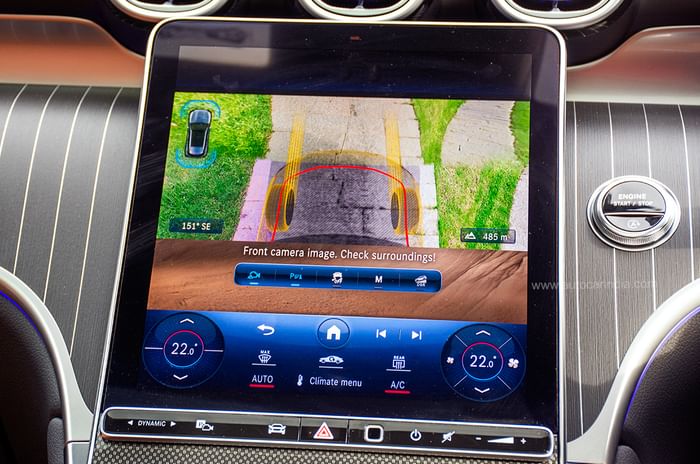
Other goodies consist of an onboard air purifier, 64-colour ambient lighting that’s all around the car – including areas like the door pads and door handles and the overhead cabin light panel – and a favourite these days, a large panoramic sunroof.
The front seats are heated, though not cooled, which would have been put to more use in our hot climate. They also lack the massage function that the previous car had. They do have three memory presets, which include positions for the seat, the reach and rake adjustable steering wheel and the outside rear view mirrors.
As with all new cars today, there is connected car tech that the company calls ‘Mercedes Me’, and a very sweet-sounding 15-speaker Burmister system.
Mercedes Benz GLC engine and gearbox
The big news under the new GLC’s bonnet is that all petrol and diesel engines are 4-cylinder units and all hybridised; either via a 48V mild hybrid or a plug-in hybrid system, while all-wheel drive and 9-speed auto are standard across the range. There’s also the Coupe and AMG versions, but we’ll see these in India only later. At launch, India will get two powertrains, both mild hybrids – the petrol 300 4Matic and the diesel 220d 4Matic.
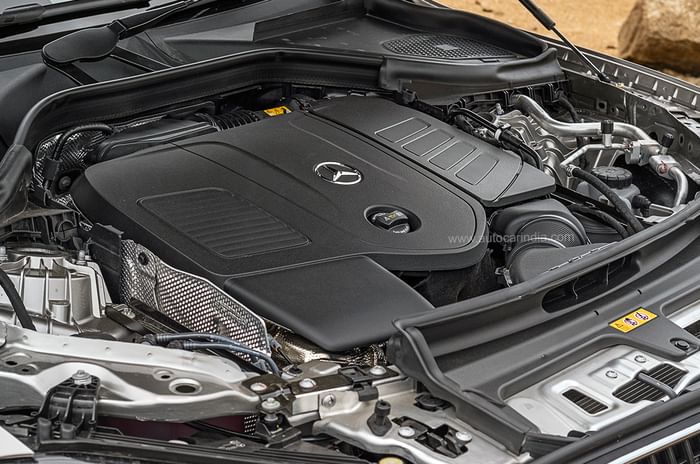
The 2.0-litre petrol makes 258hp and 400Nm of torque, plus an additional 23hp and 200Nm boost from the hybrid system’s integrated starter generator (ISG). The previous ‘300’ GLC put out 245hp and 370Nm. The 2.0-litre diesel makes 197hp and 440Nm of torque, plus an additional 23hp and 200Nm boost from the ISG. For reference, the previous diesel put out 194hp and 400Nm of torque.
We got to drive the petrol GLC in gorgeous Hampi and first impressions are very positive. Mercedes claims a 0-100kph time of 6.2 seconds, which puts it in the ballpark of the Audi Q5 (6.1secs); however, where the Audi is punchy, the Merc is very linear but it’s strong and the electric motor fills in nicely at low revs compensating for any potential turbo-lag. So when you need to get a move on, power comes in nice and smooth and does not taper soon, there’s merit in revving it further. The engine isn’t very smooth though and as you rev it further it does get audible too, thankfully though, combined with the exhaust note, it actually sounds quite sporty.
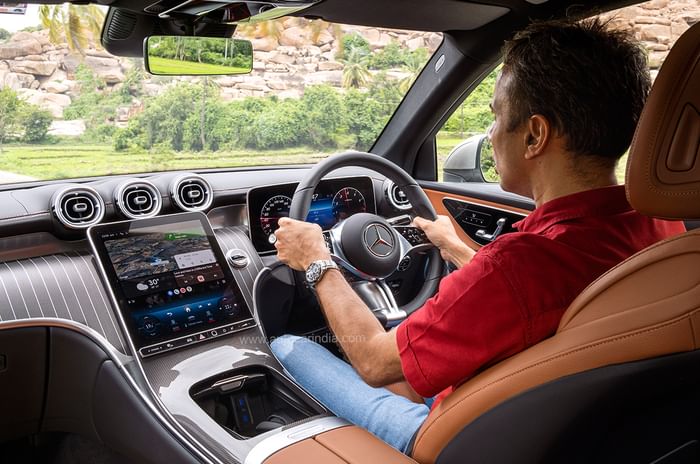
There are four drive modes on offer that alter the engine, gearbox and steering, the suspension is steel springs and dampers are non-adjustable. Of the on-road modes, Eco, Comfort and Sport are all very useable; interestingly, even Sport is useable when pottering around thanks to the smooth and linear power delivery.
Mercedes Benz GLC ride and handling
Speaking of which, steering weight and response is enjoyably sporty. It isn’t that super light one-finger effort kind, but the weight is just right and the response is quick and accurate. It’s easy to enjoy a spirited drive through well-paved twisty bits, because the ride is firm; over medium-sized potholes and ruts, you will feel and hear it crash through, it’s not uncomfortably harsh, but it’s not plush either. On the plus side though, the body roll is well-contained and the overall grip is good. The AWD drivetrain also delivers a very neutral handling setup, and will only understeer if you push real hard.
Mercedes Benz GLC price and verdict
The second-gen GLC is priced at Rs 73.5 lakh for the petrol and Rs 74.5 lakh for the diesel, and so it sits slightly above its German compatriots as well as other competitors like the Lexus NX, Land Rover Discovery Sport and the Volvo XC60 – rivals it has battled before. And as things stand, the new GLC looks fit and fine getting back into the ring.
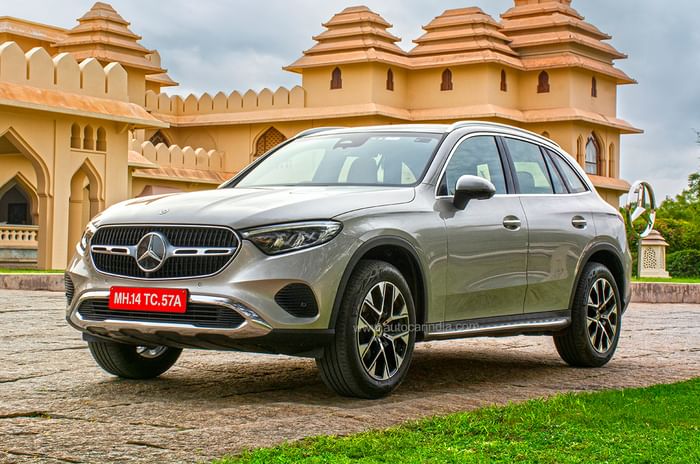
Yes, the ride isn’t plush and the seats aren’t the last word in comfort, but on the whole, as with the previous GLC, the car is a very well-rounded package. Style-wise, it’s a nice evolution over the previous car retaining the mature and elegant look. Inside, it offers plenty of space and a very modern and well-equipped cabin and from behind the wheel, it’s enjoyable with a strong engine and a confident handling. So, does this mean the new GLC can climb back to the top of Mercedes’ SUV charts? It sure looks so.












































